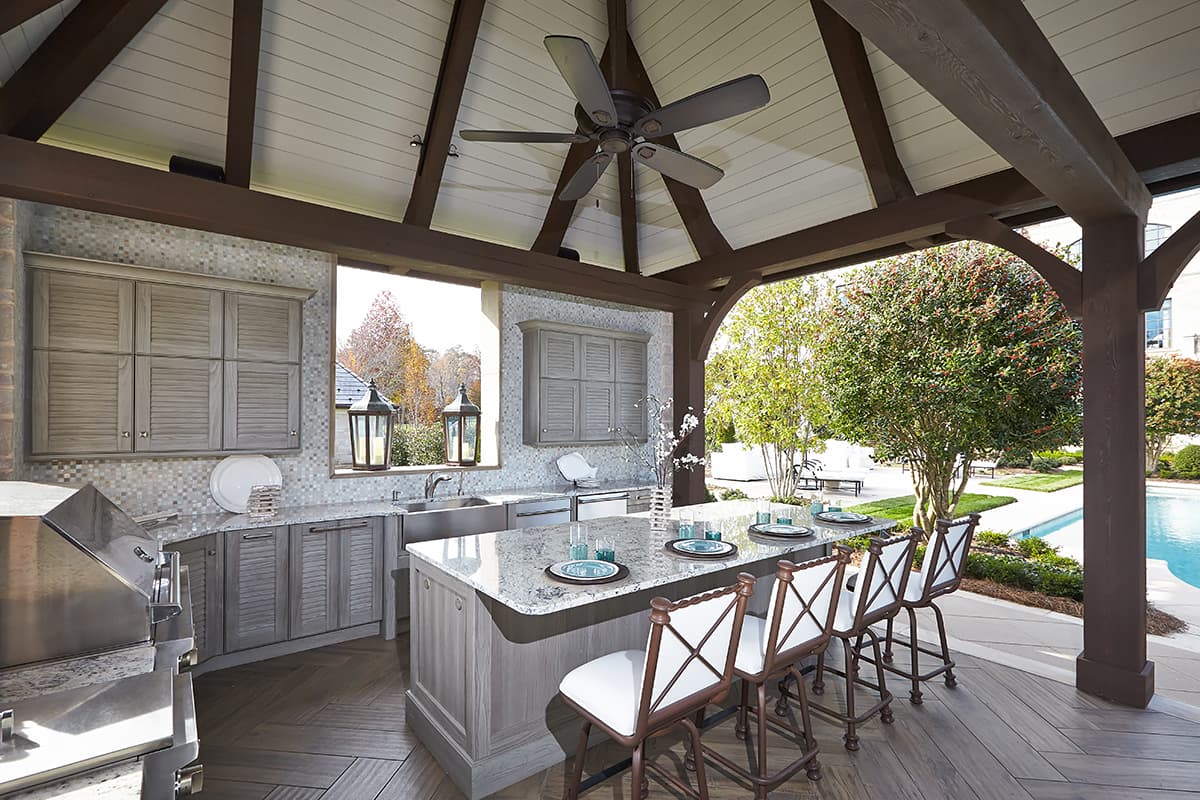
An outdoor kitchen is a significant investment that will provide years of enjoyment for your family. To protect that investment, you may be wondering if you should cover an outdoor kitchen.
Most items in an outdoor kitchen say that they’re made with durable, weatherproof materials. This implies that they’ll be fine with being exposed to the elements for a long time.
While that’s true to a certain degree, numerous factors are going to determine how fast or slow things in an outdoor kitchen will last.
To make matters a little more convoluted, if you Google “should you cover an outdoor kitchen”, you’ll get search results that are mostly related to overhead coverings for outdoor kitchens like roofs and gazebos. Also mixed in, however, are articles and product links related to coverings for individual parts of an outdoor kitchen like covers for grills and other appliances.
Whichever topic you’re looking for some help with (and maybe it’s both), we’ve got you covered with a complete guide to covering an outdoor kitchen.
Everything to know about covering an outdoor kitchen
A new, uncovered outdoor kitchen with high-quality cabinets, countertops, and appliances should last you for years before things need to be repaired or replaced because of exposure to the elements.
High-quality outdoor kitchen products are made with resilient materials that have a high resistance to corrosion, colour fading, and damage from extreme temperatures. Cheap outdoor kitchen products won’t be nearly as reliable and long-lasting, naturally.
Some outdoor kitchen appliances should be covered during the cooking season, while others don’t have to be (read more on that below). Typically, cabinets and countertops are left uncovered during the months an outdoor kitchen is in use and are covered for the winter in Ontario.
Additional factors that affect how long things in covered and uncovered outdoor kitchens will last is the climate where you live, how much sun exposure the kitchen gets, the frequency of kitchen use, and whether or not the kitchen components were properly installed.
Benefits of permanent outdoor kitchen covers
It’s recommended to add an overhead covering to an outdoor kitchen for numerous reasons:
- roof protection eliminates or reduces an outdoor kitchen’s direct exposure to rain, snow, and the sun
- items in a covered outdoor kitchen will last longer compared to the same items in an uncovered kitchen
- you can use covered outdoor kitchens more comfortably when it’s raining and on extremely hot, sunny days
- roofing keeps an outdoor kitchen’s deck or patio cleaner by protecting it from the elements (plus bird droppings and tree debris like leaves, falling branches, and sap)
- a deck or patio roof enhances the architecture of a home’s exterior and an outdoor kitchen’s décor
- a backyard roof structure makes it easier to add overhead features to the kitchen like lighting and ceiling fans
As you can see, life becomes a little easier if you have a permanent outdoor kitchen cover. You’re able to maximize your opportunities to use the kitchen when the weather won’t cooperate, including grilling during the winter.
Having an entire outdoor kitchen covered also means you won’t have to worry as much about covering up individual kitchen parts during the grilling season. If you forget to cover the barbecue after using it one day, for example, it’s less of a concern if it rains.
Even covered outdoor kitchens aren’t immune to some impact from the weather, mind you. They still have to deal with humidity, extreme hot and cold temperatures, strong winds, and a little moisture from blowing rain and snow. An overhead covering significantly reduces the impact of all these weather-related effects, however.
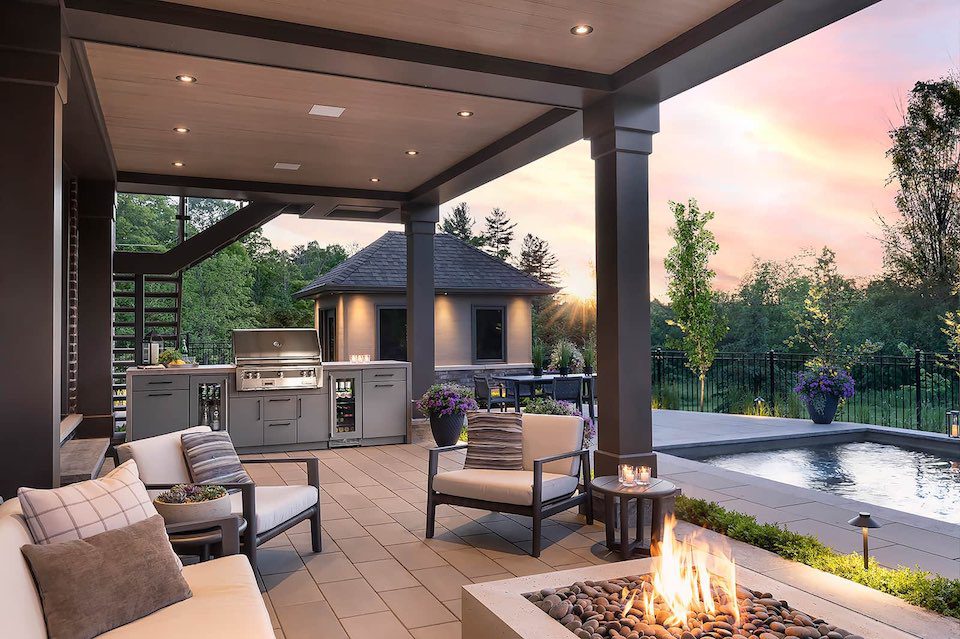
Covering an outdoor living space lets you enjoy your backyard more and extends the lives of your outdoor products.
Types of permanent outdoor kitchen covers
If you’re looking for options to cover an outdoor kitchen, there are plenty of types of coverings to choose from. They include the following:
Canopy: The least expensive option to cover an outdoor kitchen is a canopy. Canopies can be used as standalone structures or sturdier structures like pergolas and gazebos sometimes use a canopy for the roof.
Awning: This backyard covering solution comes in fixed and retractable forms. Retractable awnings are better since they give you the option to leave decks and patios uncovered when the weather is nice. Awnings are operated manually with a hand crank or are motorized. Higher-end retractable awnings can be operated with a smartphone app and have wind sensors that will automatically retract the awning in high winds.
Pergola: This type of deck and patio cover has a semi-open design. The slatted roof lets you enjoy the sun while providing some shade covering. The downside of pergolas, of course, is that there’s no protection from the rain.
Gazebo and pavilion: These similar freestanding structures with coverings are commonly confused with one another, but have a few differences. Gazebos usually come in oval, octagonal, and hexagonal shapes and sometimes have surrounding rails. Pavilions are typically square or rectangular and are open on the sides.
Roof extension: The other way to cover an outdoor kitchen is to extend the roof of a house over a deck or patio. This creates a more seamless extension of a home’s living space. In comparison, an outdoor kitchen beneath a pergola, gazebo, or pavilion that is further away from the house creates a more separate, defined backyard living area.
Another thing to consider when you’re deciding which roof option to get is drainage. An outdoor kitchen roof needs a good drainage system so flooding doesn’t damage the deck or patio foundation or the bottoms of your kitchen cabinets.
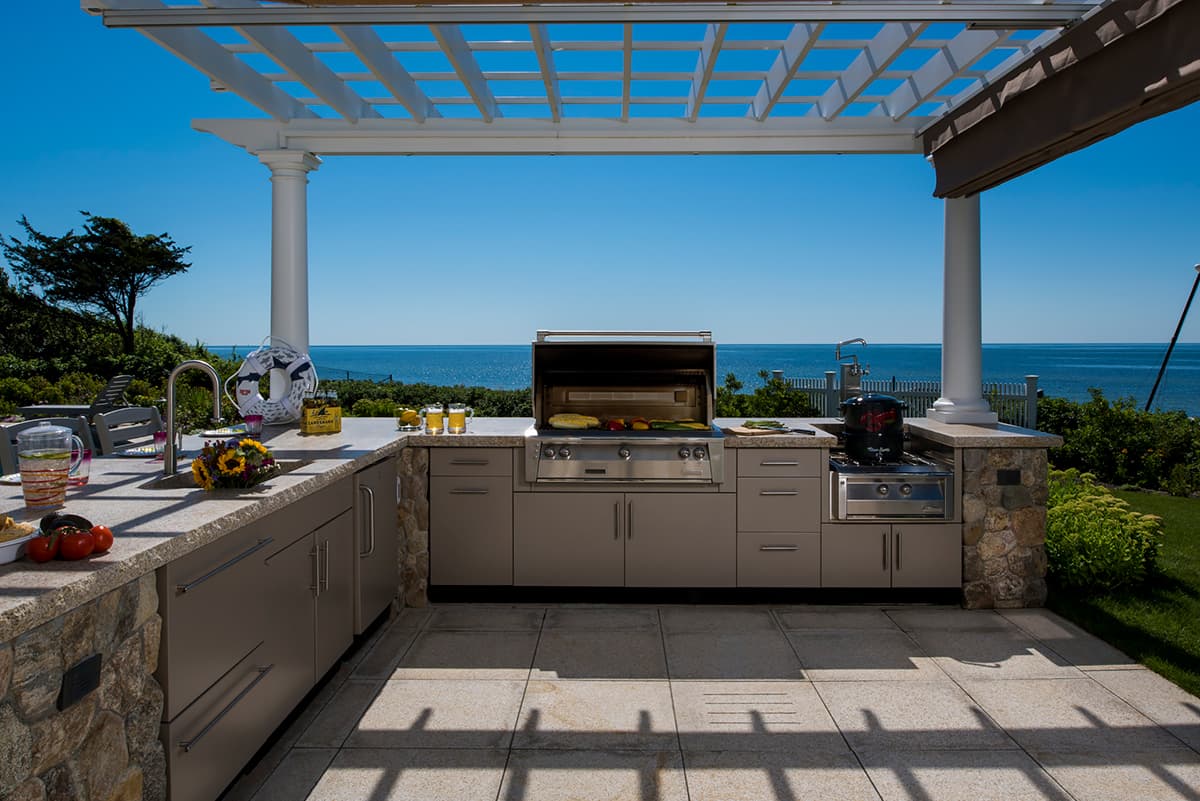
A pergola is one of several types of outdoor kitchen coverings available.
Use ventilation if you cover a backyard kitchen
If your outdoor kitchen is covered with a roof, it’s a good idea to install a ventilation system. More enclosed kitchen designs have a greater need for ventilation. Adding a grill vent hood is wise even if you have a fairly open kitchen layout or a partial overhead covering. Here’s why grill vent hoods are so useful:
- grill smoke is quickly removed from the kitchen, resulting in less eye, nose, and throat irritation for everyone in the area
- cooked food smells exit the kitchen faster
- there’s less smoke stain and residue build-up on kitchen surfaces
- grill heat is dispersed more efficiently, which is helpful on hot days
Should you cover a grill?
The grill in an outdoor kitchen should always be covered when it’s not in use, even if the kitchen has a roof over it.
Grills that have less exposure to the elements will simply last longer, require less maintenance, and function more reliably. Covering a grill also prevents critters like birds, mice, and squirrels from using the appliance as a home.
It’s fairly common for a grill to occasionally be left uncovered overnight or even for a few days because it was left to cool off and someone forgot to cover it. Grills that range in quality from average to high shouldn’t have any issues if this happens on occasion, even if they get directly rained on. Cheap grills won’t fare as well in these situations, however.
Just make sure you’re not using a cheap grill cover that doesn’t breathe well or a grill cover that got wet on the inside. This can trap moisture, which will accelerate how fast the grill starts to corrode.
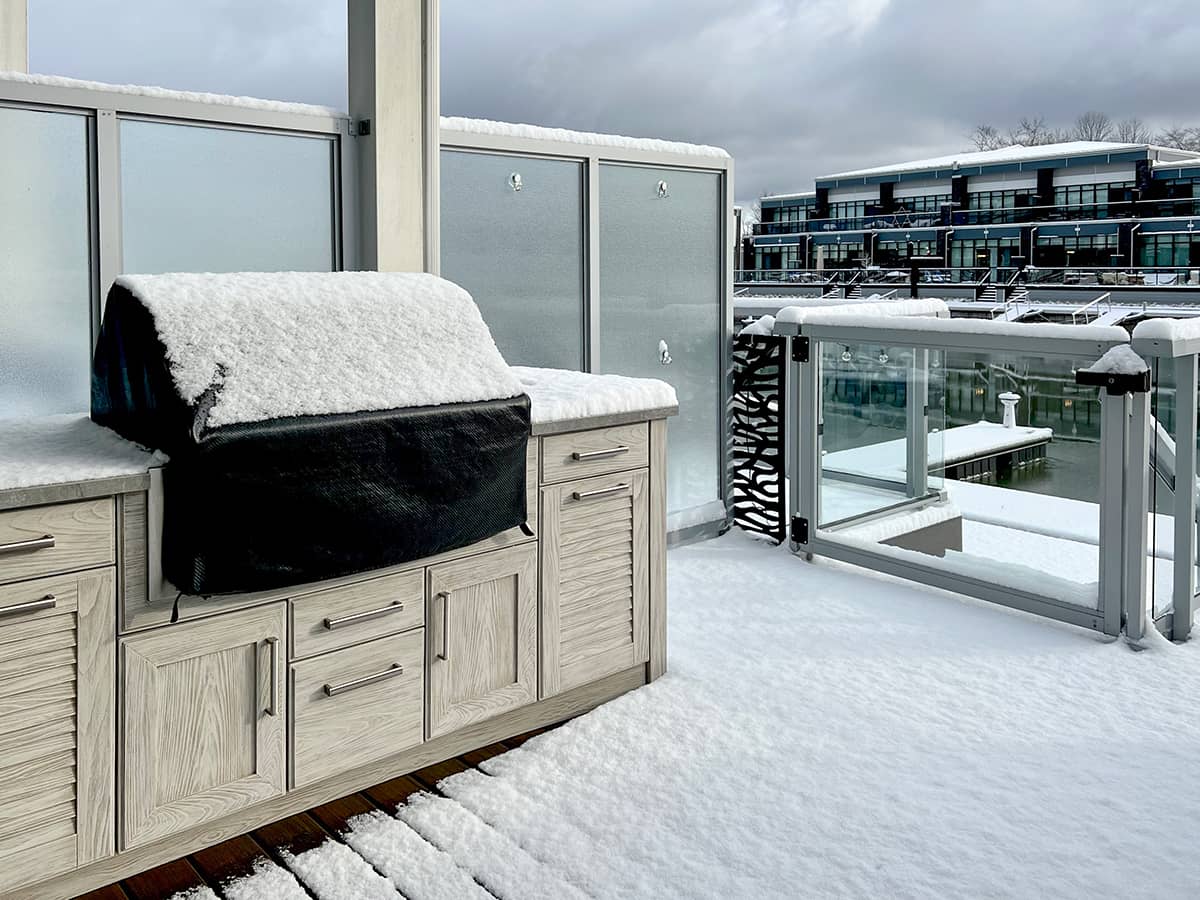
Which outdoor kitchen appliances should you cover?
Some other outdoor kitchen appliances will benefit from being covered when they’re not in use during the cooking season.
Regularly covering appliances like side burners, flattop grills, and an outdoor oven will extend their life and reduce the time needed to clean and maintain them. If you cook outside several times a week and use all your appliances regularly, covering them is less necessary if they’re in a covered space.
The only outdoor kitchen appliances you shouldn’t ever cover are refrigerators and ice makers, even during the winter. The reason is that these appliances are more likely to accumulate moisture. Even though their electrical components are designed for outdoor use, trapping moisture beneath a cover can still cause damage.
Before winter arrives, refrigerators, ice makers, and other outdoor appliances that use water (like a beverage dispenser and dishwasher) should have their water lines drained. The fridge interior should be cleaned and dried before it’s retired for the winter.
Covering outdoor cabinets is optional
Outdoor kitchen cabinets on a deck or patio with or without a roof don’t need to be covered during the grilling season. Whether or not you should cover them for the winter largely depends on their quality.
Premium cabinets are constructed with the highest-quality steel and typically have powder-coated finishes. This type of finish protects against corrosion and discolouration, so covering them during the winter isn’t necessary.
Brown Jordan says their cabinets are “engineered to remain durable when exposed to all types of weather with minimal maintenance”. Covering them for the winter “can reduce maintenance and offer extra protection for peace of mind.”
Covering countertops and the sink
Outdoor kitchen countertops don’t need to be covered at any time of the year. The materials they’re made with are extremely resilient and will last for years if they’re well-maintained.
Certain types of countertop materials need to be resealed at least once a year to prevent stains and other surface damage. This includes countertops made with:
- granite
- concrete
- quartzite
- slate
Outdoor sinks should be covered during the winter and during the grilling season if they’re in an uncovered kitchen near a lot of trees.
When you’re covering up for the winter, use a snug cover that is specifically made for your sink model. The cover will protect the sink from filling up with rain water and snow and prevent debris like branches and leaves from clogging the drain.
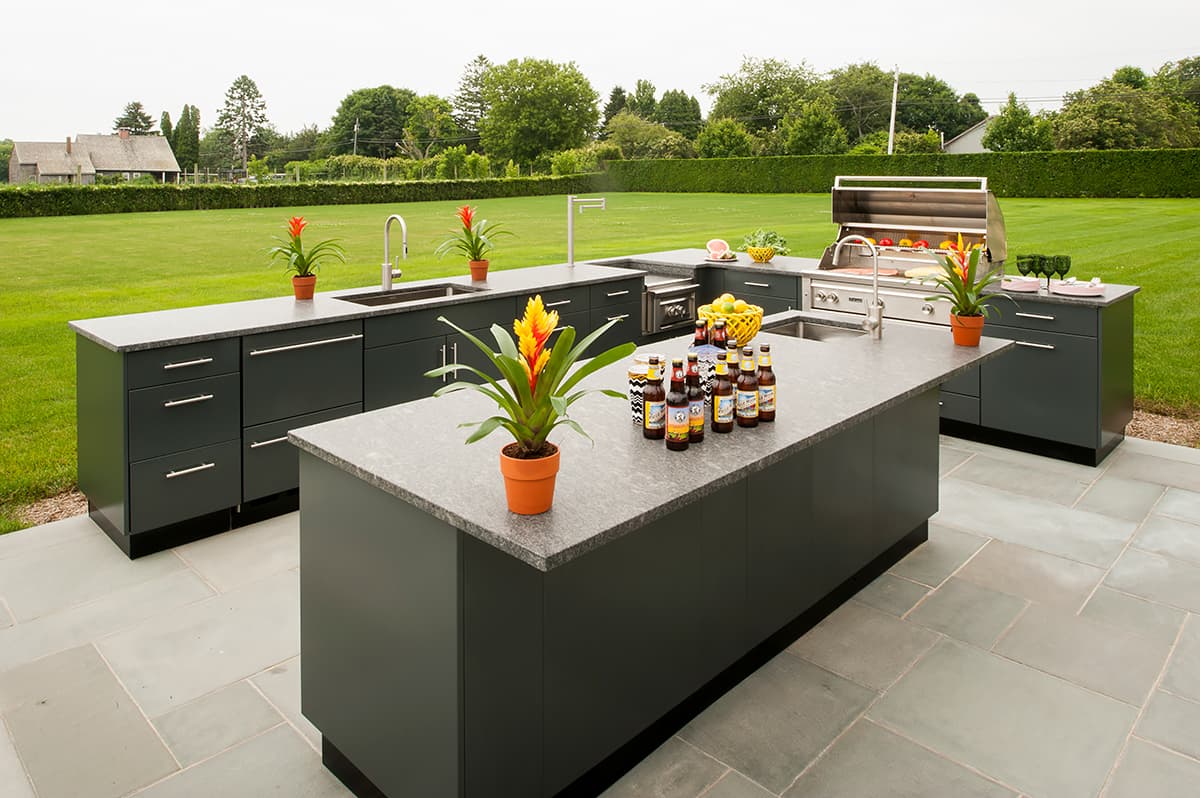
Outdoor kitchen countertops need occasional maintenance, but don’t have to be covered.
What to look for when buying outdoor kitchen covers
As we’ve mentioned, it’s important to use high-quality covers for anything that is being individually covered in an outdoor kitchen. Using a cheap cover that traps moisture against an appliance can actually do more harm than if you left the appliance uncovered.
Just because an outdoor cover is heavy doesn’t mean it’s effective. The key is proper ventilation. Make sure the covers you use have a design that allows some airflow to let moisture and humidity escape. Covers that have retention hooks will ensure they stay anchored in high wind conditions, too.
Add a beautiful outdoor kitchen to your backyard
If you’re planning to build a new backyard kitchen or are looking to upgrade an existing outdoor cooking space, now you have all the facts about whether or not you should cover an outdoor kitchen.
If you’re ever in doubt about whether or not something in an outdoor kitchen should be covered, consult with the product manufacturer or your kitchen designer.
Get your outdoor kitchen project started by scheduling a free design consultation with Outeriors today.
Please share this post if you found it useful.